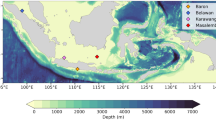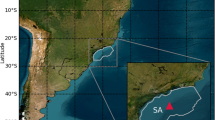Abstract
The prediction of internal solitary waves (ISWs) propagation is a difficult problem in the field of oceanography due to the complexity of its generative mechanism and the lack of in-situ data. In this paper, the simulation data is used to establish a prediction model of ISWs propagation in the southern Andaman Sea by deep learning. The global tidal model TPXO7.2 is used to obtain the semi-diurnal tidal velocity data at the generation source of ISWs. The generation and propagation characteristics of ISWs are obtained by the Massachusetts Institute of Technology General Circulation Model (MITgcm). The generative location, amplitude, and propagation characteristics of the ISWs are calculated based on MITgcm. The database is set up by the extracted data from MITgcm. Then, the prediction model of ISWs propagation is established using long and short-term memory (LSTM) networks. Finally, the accuracy of the model is verified by the ISWs Moderate Resolution Imaging Spectroradiometer (MODIS) images of the southern Andaman Sea and in-situ data. The results demonstrate that, compared with the MODIS images, the average relative error of time predicted by the LSTM model is 17.81%, and the average absolute error is 0.95 h. The average relative error of longitude predicted by the LSTM model is 0.10%, and the average absolute error is 0.10°. The average of the amplitudes predicted by the LSTM model is 56.99 m. The in-situ data of the amplitude of ISWs is 60 m in the previous research. The two amplitudes are relatively close.









Similar content being viewed by others

References
Chen W (2018) Forecasting volatility of shanghai composite index with deep learning. Stat Inform Forum 33:99–106
Da Silva JCB, Magalhaes JM (2016) Internal solitons in the Andaman Sea: a new look at an old problem. Remote Sens Ocean Sea Ice Coast Waters Large Water Reg. https://doi.org/10.1117/12.2241198
Gao X, Wei Z, Lv X, Wang Y, Yang Y (2014) Accuracy assessment of Global Ocean Tide Models in the South China Sea. Adv Mar Sci 32:1–14
Hochreiter S, Schmidhuber J (1997) Long short-term memory. Neural Comput 9:1735–1780
Hyder P, Jeans DRG, Cauquil E, Nerzic R (2005) Observations and predictability of internal solitons in the northern Andaman Sea. Appl Ocean Res 27:1–11
Lecun Y, Bengio Y, Hinton G (2015) Deep learning. Nature 521:436
Osborne AR, Burch TL (1980) Internal solitons in the Andaman sea. Science 208:451–460
Peng Y, Liu Y, Zhang R (2019) Modeling and analysis of stock price forecast based on LSTM. Comput Eng Appl 55:209–212
Raju NJ, Dash MK, Dey SP, Bhaskaran PK (2019) Potential generation sites of internal solitary waves and their propagation characteristics in the Andaman Sea-a study based on MODIS true-colour and SAR observations. Environ Monit Assess 191:8091–80910
Shimizu K, Nakayama K (2017) Effects of topography and Earth’s rotation on the oblique interaction of internal solitary-like waves in the Andaman Sea. J Geophys Res-Oceans 122:7449–7465
Sun L, Zhang J, Meng J (2019) A study of the spatial-temporal distribution and propagation characteristics of internal waves in the Andaman Sea using MODIS. Acta Oceanol Sin 38:121–128
Tong X, Tan C, Feng W, Liu Y (2016) Prediction model for generation of internal wave using fuzzy logic inference method. Hydrogr Surv Charting. https://doi.org/10.3969/j.issn.1671-3044.2016.06.007
Wang G, Zhang Y, Zhao C, Dai D, Qiao F (2017) Source site of internal solitary waves in the northern south china of westward shoaling thermocline. Nonlinear Proc Geoph. https://doi.org/10.5194/npg-2017-57
Yan M, Fan Z, Fu S, Liu C (2010) Preliminary discussion of the necessity and feasibility of study of internal wave prediction techonology. Mar s 27:76–81
Zhang Z, Fringer OB, Ramp SR (2011) Three-dimensional, nonhydrostatic numerical simulation of nonlinear internal wave generation and propagation in the South China Sea. J Geophys Res. https://doi.org/10.1029/2010jc006424
Zhou L, Yang J, Wang J, He S, He Z, Liu AK, Hsu M-K (2016) Spatio-temporal distribution of internal waves in the Andaman Sea based on satellite remote sensing. In: 2016 9th international congress on image and signal processing, biomedical engineering and informatics. https://doi.org/10.1109/cisp-bmei.2016.7852785
Acknowledgements
This work was supported by the National Key R&D Program of China (2017YFC1405600), and the Natural Science Foundation of China (61871353).
Author information
Authors and Affiliations
Corresponding author
Rights and permissions
About this article
Cite this article
Lu, K., Wang, J. & Zhang, M. Study on prediction of internal solitary waves propagation in the southern Andaman Sea. J Oceanogr 77, 607–613 (2021). https://doi.org/10.1007/s10872-021-00594-6
Received:
Revised:
Accepted:
Published:
Issue Date:
DOI: https://doi.org/10.1007/s10872-021-00594-6



